You may not have realized this, but chances are you’ve crossed paths with Feldspar hundreds of times throughout your life. Feldspar isn’t exactly a gemstone. Instead, it’s an Alumina and Silica inclusive mineral.
Feldspar holds the title of being Earth’s most abundant mineral, and it makes up approximately sixty percent of the rocks we see daily.
Types of Feldspar
Feldspar consists of much more than simple rocks and minerals. As I mentioned above, there are currently two varieties of Feldspar that create gemstone-quality stones: Plagioclase and Orthoclase, both of which produce beautiful gems.
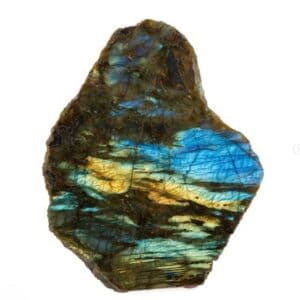
Plagioclase Feldspar
Members of the Plagioclase group are among the most common rock-forming minerals. They’re essential dominant minerals in most igneous rocks in the Earth’s crust. Plagioclases are significant constituents in various intrusive and extrusive igneous rocks, including Dorite, Granite, Rhyolite, Basalt, Andesite, and Gabbro.
Plagioclase minerals are also important constituents of different metamorphic rocks, like Gneiss, where they can be inherited from an igneous protolith or form during the regional metamorphism of sedimentary rocks.
Now that we have the technical description out of the way let’s dig into some of the most well-known types of Plagioclase Feldspar.
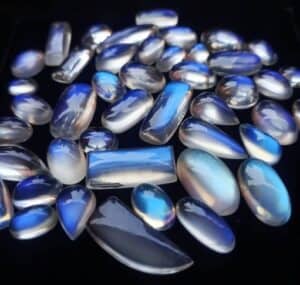
Moonstone
Moonstone has to be one of the most well-known varieties of Plagioclase Feldspar and for good reason. This beautiful gem material consists of very thin, alternating layers of an Alkali Feldspar (Orthoclase) and a Plagioclase Feldspar (Albite).
Light entering these stones interacts with the thin layers to produce adularescence. This phenomenon causes a white-to-bluish light that floats under the surface of the stones when it’s turned under a light source.

Sunstone
Sunstone is the name that’s been traditionally given to transparent Labradorite Feldspars containing plate-shaped copper inclusions, which share a common alignment with the mineral. When cabochons or faceted gems are cut from this beautiful material and are moved under light, reflected light or bright flashes are produced as the rays strike platelets being moved to an angle that they reflect the rays.
These flashes of reflective particles are known as aventurescence or aventurization. Oregon produces transparent gem-quality Labradorite that can be red, orange, yellow, green, or blue; they are also called Sunstones when they’re mined from the same deposit as the aventurescent materials.
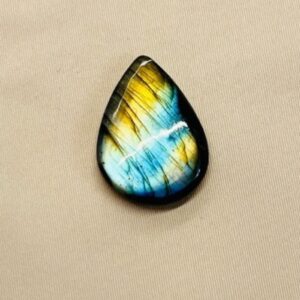
Labradorite
Labradorite can be a little confusing because there are two well-known types. The most popular produces a Schiller effect, see image above, and the other type is a light yellow stone that is transparent.
The Schiller effect is a strong play of iridescent green, blue, orange, red, and yellow colors when the stone is moved under light. Labradorite is so well-known for its incredible display of color that the phenomenon is commonly known as labradorescence.
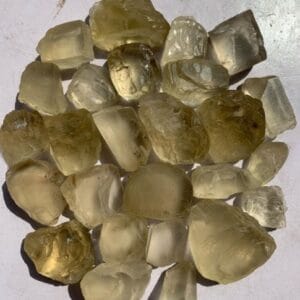
Orthoclase Feldspar
Amazonite is a variety of potassium Feldspar. This beautiful sea-green mineral is assumed to be named after the incredibly mesmerizing shades of the Amazon River. Still, Amazonite hasn’t actually been linked to the location.
Orthoclase Moonstones display the optical phenomenon of Adularescece. The internal repeating layers of Feldspar scatter light that enters the stone, which creates a mystical white glow that is reminiscent of moonbeams. The stones can be colorless white, yellow, orange, or brown.
Orthoclase Sunstones produce an aventurescent variety of Orthoclase Feldspar. Some of the best specimens are said to come from Hart’s Range in Australia. This material is referred to as Rainbow Lattice Sunstone within the gemstone trade. The material contains Ilmenite and Hematite platelets that show rainbow interference colors.
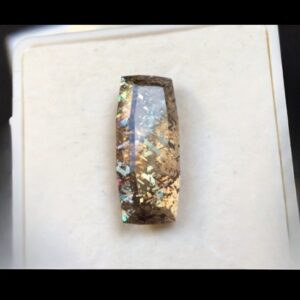
Feldspar Uses
Plagioclase Feldspar is commonly used in glass, ceramics, enamel, scouring powders, and false teeth. These minerals are important constituents of some building stones and crushed stones like Granite.
These stones are also cut and polished to be used as stair steps, countertops, wall paneling, building facing, monuments, and a variety of decorative and architectural stones.
Orthoclase Feldspar has several commercial uses. The raw material is used in the production of glass, porcelain, ceramic tile, bathroom fixtures, dinnerware, and other ceramics. It’s also used as an abrasive in powders and polishing compounds.
What Is Feldspar Twinning?
There are two types of Feldspars, Sandine, and Orthoclase, that are the most commonly twinned minerals within the monoclinic system. Both penetration twins and contact twins occur, with both types resulting from accidents during their growth.
Feldspar twinning can result from growth, deformation, or transformation. It’s a polysynthetic contact type of twinning and displays a similar appearance to albite twinning. However, there is a different crystallographic orientation.
Suppose crystals are subjected to stress, temperature, or pressure changes that differ from those in which they originally formed. In that case, two or more intergrown crystals form symmetrically. While twinning doesn’t always occur, it can happen sometimes, and more so with certain crystals.
These symmetrical intergrowths of crystals are Twinning. Twinning is an essential characteristic to recognize because when it happens, it’s often one of the most diagnostic features that allow us to correctly identify the mineral/minerals.
- Identify Enstatite - March 12, 2024
- Identify Cerussite - March 3, 2024
- Identify Bytownite - February 18, 2024
